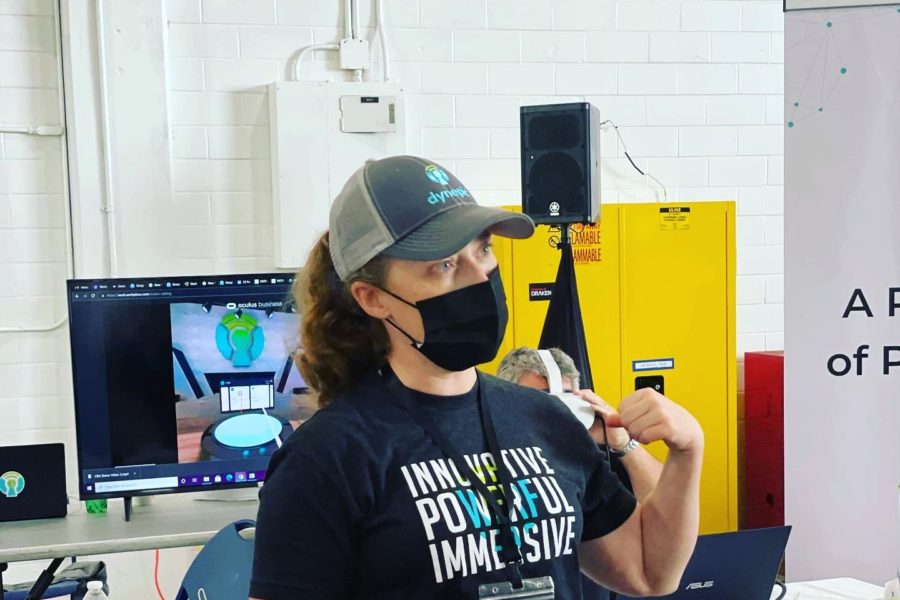Air Education and Training Command has validated a new platform to keep track of disparate augmented and virtual reality training programs across the command with the goal of speeding up the training pipeline and creating a digital training record that will follow Airmen throughout their careers.
The new technology, developed by Dynepic and dubbed the Member Operations Training Analytics and Reports (MOTAR) platform, will soon be distributed to AETC wings—and the rest of the Air Force is taking notice.
“Basically, what we are is the glue that pulls all these augmented reality, virtual reality mobile applications” into a “central portal,” said Krissa Watry, co-founder and CEO of Dynepic Inc. MOTAR enables applications from various companies to be “distributed into courses,” creating a “seamless user experience for the student and instructor.”
It also collects user data into a single interface, creating digital training records for Airmen, and includes live learning dashboards so instructors can monitor students’ progress.
The company won the AFWERX Mixed Reality Challenge in 2019 followed by a series of Small Business Innovation Research Phase 1 and 2 contracts then a multiyear Phase 3 contract supporting AETC’s Maintenance Training Next program, which has since evolved into Technical Training Next.
During the pilot program, MOTAR powered a revamped Crew Chief Fundamentals Course at Sheppard Air Force Base, Texas, with a single login and consolidated dashboard for various AR/VR applications, according to a company release. The web-based, device-agnostic platform also hosted 360-degree videos, documents, and assessments so participants in the crew chief course could learn whichever way suited them best.
Dynepic also won AFWERX’s 2020 Recruiting, Reimagined Challenge, adding recruiting elements to the MOTAR platform for both the Air and Space Forces, and it was one of seven companies to win AFWERX’s Accelerating Pilots to Combat Ready Aviators Challenge, adding another 15 products to the MOTAR platform in support of aircrew training.
Andrea Hagen, a program analyst with Air Combat Command’s Capability Development Engine Room, told Air Force Magazine that although the command is much earlier in the process than AETC, the platform could one day play into ACC’s Reforge fighter pilot training plan. Reforge looks to cut in half the time needed to transform a recently graduated student pilot into a fighter flight lead by pairing the new T-7 Red Hawk’s in-jet simulation capability with ground-based virtual reality and artificial intelligence.
“One of the things we are missing is a [Learning Management Sytem] we can use across different FTU school houses,” Hagen said. “We have multiple around ACC. They’re kind of all doing their own thing, but we’re looking for one common platform, and MOTAR kind of fits that bill.”
The Air Force Life Cycle Management Center Simulators Division at Wright-Patterson Air Force Base, Ohio, also selected MOTAR for its new Lightweight Simulators Ecosystem (LSE) during its Simulators Pitch Day, according to a company release.
Margaret Merkle, AFLCMC’S chief innovation officer for simulators, told Air Force Magazine the service is striving to bring together various digital training assets and capabilities into one platform so Airmen can access them from anywhere anytime they need it.
“Today, things are stovepiped in certain areas where they are developed, and that’s very hard to … reach back into those records from different disparate systems,” she said. “This gives us a platform to make that connectivity of all that performance data for those Airmen across the commands,” and though training remains with the individual major commands, Merkle said, “We see this as a tool to enable that to be done easier and delivered more quickly.”
Merkle and Hagen were among the 300 people from various commands, including AETC, ACC, Air Force Special Operations Command, and AFLCM, to attend the MOTAR Expo at Joint Base San Antonio’s Kelly Field on Nov. 4.
The expo offered Air Force units a chance to share how they are using the platform and showed those considering adopting AR/VR tech in the future ways it might be useful for them. Air Force representatives had a chance to interact with 28 different MOTAR vendors and learn how they are advancing immersive technologies and using the MOTAR platform to rapidly distribute it.
“What we’re looking to do here is to get cross communication between all of the different parties … and learn lessons from each other, share progress with each other,” Merkle said. “What MOTAR brings to bear on this is the fact that we can share digital assets underneath these various projects to allow each project to build faster towards their end point and not repeat steps early in the development cycle.”
She offered the example of taking an aircraft offline to make digital scans of it. Those scans can then be shared with different entities looking to build training programs centered around that aircraft. One group may be looking to build a training program to teach the proper way to load weapons on that aircraft, while another will teach how to maintain it, and yet another could use the simulation for pilot training.
“We could take that one digital model and share it with all three of those projects,” Merkle said. “And each one of them will progress a little faster because they don’t have to do the same things over and over again.”
